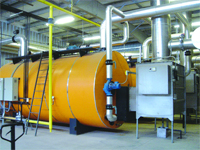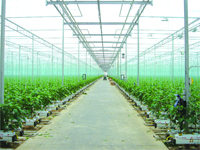
Features
Efficiency
Energy
Energy optimization: Saving $1 on energy is the same as bringing in $20 of additional sales
March 14, 2008 By Ryan Lang
There’s no question that energy costs are among the major challenges faced by commercial
growers. Considering natural gas usage can often amount to over 40 per
cent of total costs and rank as one of the top three expenses, it’s no
wonder many growers have been actively searching for solutions.
There’s no question that energy costs are among the major challenges faced by commercial growers. Considering natural gas usage can often amount to over 40 per cent of total costs and rank as one of the top three expenses, it’s no wonder many growers have been actively searching for solutions.
 |
| Whether your greenhouse is large (top) or small, having an energy budget is imperative. Photos by Ryan Lang/360 Energy |
 |
Frequently, the emphasis is placed on conservation. Historically, energy has been addressed within organizations as strictly a technical issue. Although technical insight is absolutely essential when making energy decisions, decision-making itself has often lacked a business acumen and focus through this exclusively technical approach.
A strictly technical approach will lead to strictly technical solutions, usually requiring capital investment. However beneficial the proposed solutions might be, this capital hurdle can be insurmountable and can effectively stall progress. Even if capital projects are approved, the projected savings are not necessarily proven or continual.
There is no debate as to the global benefits of conservation. However, when these programs are not integrated with all organizational activities, the effectiveness is limited. Although reducing usage can lead to sustainable cost reductions, there are many additional savings opportunities available.
To use a sports analogy, conservation is a defensive approach. While conservation measures are an important part of the game plan, in order to remain competitive, greenhouses must also take a proactive approach when it comes to purchasing energy. By combining a solid business philosophy with a disciplined approach, any grower has the capability of controlling and reducing their
energy costs.
The challenge for some growers is in knowing where to begin. This is where a flexible, customized purchasing strategy comes into play. However, taking a well-disciplined, non-emotional approach to purchasing natural gas encompasses more than simply knowing when to buy. There are a number of items of which a grower should
be aware.
DO NOT REST ON YOUR LAURELS
To put this into perspective: Do you still grow your flowers or vegetables using obsolete, non-mechanical, heavily time-consuming methods? After all, it worked in the past and it’s proven so why wouldn’t you continue with the status quo? Instead, you now use modern techniques because you have adapted to new technologies and changing market conditions. You have also addressed the need to reduce costs. As the market changes, so should your energy saving strategies.
BUDGETING AND FIXING-IN PRICES
When controlling your expenditures, a realistic budget should be created outlining transportation, commodity, and distribution (utility) charges. In addition, the amount of gas that you expect to consume based on weather, production changes, or expansionary plans should be included since these factors may have a large impact on overall costs.
 |
| Natural gas usage can often amount to over 40 per cent of total costs. |
Whether your company is large or small, having a budget is imperative. For example, Gerry Vermeer of Vermeer’s Garden Centre & Flower Shop in Welland, Ontario, has recently expanded his operations by 11 per cent. By combining a solid business philosophy with a well-disciplined, non-emotional approach, he decided to fix-in 25 per cent of his load for the winter season (through to the end of March 31, 2008) at a price that was 12.4 per cent lower than his budget. He can now spend the money he saved on other energy-saving initiatives. He is also able to capture additional savings if and when prices continue to decline by continuing to lock-in his prices. If gas prices reverse direction, at the very least he’s partly protected and can still fix-in prices below his budget. We’ll examine optimal purchasing strategies shortly.
MARKET AWARENESS
Knowledge about current and future market conditions, historical trends, future projections and possible utility changes all contribute to making the best energy management decisions. Having daily pricing sheets readily available keeps suppliers on their toes and their prices sharp, leading to bottom-line savings. Let’s assume the average net profit margin is five per cent; saving $1 on energy costs is the equivalent of bringing in $20 of additional revenue.
As you can see, the impact to your bottom line is significant. One greenhouse (which will remain nameless for com-
petitive reasons) had fixed-in a large percentage of its gas costs for five years beginning in 2004. During the summer of 2005, during hurricanes Katrina and Rita, the price of natural gas escalated by 100 per cent. By having the right information in hand, this greenhouse was able to sell off a portion of its future position and pocket over $110,000 in profits. Using the previous example, the savings equate to $2,200,000 in sales. Not only does this lend support to prudent long-term planning around a budget, but also having the information available to capitalize on a great opportunity. Being knowledgeable about the energy industry allows you to take advantage of the market instead of the market taking advantage of you.

|
| Saving $1 on energy costs is the equivalent of bringing in $20 of additional revenue. |
LOAD BALANCING
For direct purchase consumers, the same quantity of gas is delivered on a daily basis regardless of the time of year.\ Based on yearly forecasts, the amount delivered should be equal to what has been consumed by the end of their utility contract. More gas is typically consumed in the winter months (more than what is delivered) compared to what is used in the summer (less than what is delivered). This discrepancy should be looked at on a monthly basis to ensure the account doesn’t deviate too far away from your expectations. If it does, there are a number of buying/selling options each with its own set of advantages and disadvantages.
First, you can buy/sell your gas to another greenhouse or end-user. If you employ an energy consultant, they can do all of the legwork for you by finding another end-user in an opposite position, negotiating the price, finalizing all the paperwork, and sending/receiving the required funds. Along similar lines, you can buy or sell your gas with other energy consultants or even back to your supplier. The final option, which at times of high volatility can be the best solution, is to buy/sell gas to your utility. This sort of transaction was particularly popular after hurricanes Katrina and Rita blew through the Gulf of Mexico and disrupted gas supply. The option of selling your gas to the utility two months after the hurricanes (if you were fortunate to be in that position) was of significant value and would have beaten the market.
PURCHASING OPTIONS
Many growers are anxious to lock-in the price of their gas all in one transaction. However, a more prudent strategy is to lock-in your prices in a staggered fashion over a longer period of time to catch market opportunities.
Additionally, having at least three natural gas suppliers to approach, with respect to pricing, is invaluable. As their portfolios continuously change, a supplier that was the most competitive yesterday may, in another instance, lag behind the others today.
 |
| Growers are taking a long look at energy costs. |
Many believe that locking-in prices with a fixed price is the only option. Invariably, it is not; there are a variety of other options that could be attractive based on your risk tolerance.
For example, a price cap is quite popular and can be purchased with a small up-front premium. Let’s take a look at this type of investment in detail. Let’s assume it’s nearing the end of the winter and the spot market is trading around $5.50 CDN/GJ. You want to protect yourself against summer hurricanes and the inevitable price increases they bring, so you purchase a price cap at $7.00 CDN/GJ for a premium of $.40 CDN/GJ. Essentially the highest amount you would pay is $7.40 CDN/GJ (the cap plus the premium). If the spot market price ends the term at $6.00, you would pay $6.40. If spot market prices end the term at $9.00, you would only pay $7.40. This is a great way to protect your company’s profits, yet still participate in downward market declines. In essence, you pay the spot market price plus $.40 up to a maximum of $7.40.
Along similar lines, as a price cap there are costless collars (price cap and a price floor), participating swaps (you choose the percentage of the downward decline you want to participate in and your premium fluctuates depending on your decision – a price cap is a 100 per cent participating swap), call spreads, three-ways and other exotic sounding options.
Whether you use options or the traditional fixed-price approach, these products should be used in conjunction with each other when attempting to beat your budget. This helps reduce the risks of a market that changes every minute. If you attempt to beat the market, ideal prices may pass you by.
 |
| Ryan Lang is a project manager with 360 Energy. |
Structuring a longer-term strategy has proven to be very successful. For example, taking a look at the Fig. 1 charts, purchasing 25 per cent of your commitments for each of the three years (every year) allows not only for stronger budgets but takes the emotion out of your decision. Keep in mind that the same strategy won’t work for everyone. The strategy must be flexible enough to meet your changing needs.
For instance, Toine vander Knaap from St. David’s Hydroponics in Beamsville, Ontario, took a similar approach in July 2006 when purchasing the company’s transportation (the portion that delivers the gas from Alberta to Ontario). At that time, transportation for November ’07 to October ’08 was looking quite attractive. They fixed-in 50 per cent of their transportation load at a price that was trading at a 6.4 per cent discount to their current price. Transportation usually accounts for approximately 10-20 per cent of the total expenditure on natural gas. Once again, significant savings were achieved by taking a proactive approach to purchasing energy.
In the end, conservation is important and you should keep those initiatives employed – just don’t overlook the savings on the energy coming in.
Ryan Lang, a project manager with 360 Energy, specializes in developing optimal natural gas purchasing strategies based on clients’ needs.
• www.360energy.net
 |

|
 |
Print this page